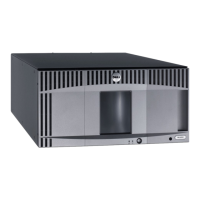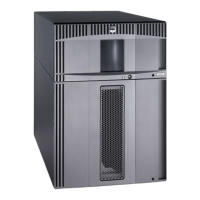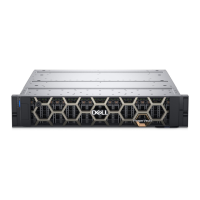Troubleshooting
file:///T|/htdocs/stor-sys/ML6000/en/html/ch09.htm[9/17/2012 1:50:53 PM]
The paths to open the appropriate screens are as follows:
• From the Web client, select Setup > IO Blades > Blade Control.
• From the operator panel, select Setup > IO Blades > Blade Control > Reset Port.
Viewing and E-Mailing the Command History Logs
When FC I/O blades are installed, administrators can use the Command History Log screens to view the most recent
command and response activity that has occurred with externally addressable library devices, controller LUNs, partitions, and
tape drives. This information can help you isolate the source of an issue, such as a library device or host application.
You can select any configured FC I/O blade in the library and display a list of associated library devices. For each device, you
can view the command history log. You can also choose to e-mail the command history to a specific e-mail address. The log
is sent as a text file attached to an e-mail message.
Before you can e-mail the command history log, the library e-mail account must be configured. For information on setting up
the e-mail account, see
Configuring the Library E-mail Account in Configuring Your Library.
You cannot view command history logs from the Web client. The path to open the appropriate screen is as follows:
• From the operator panel, select Tools > Command History Log.
Interpreting LEDs
LEDs provide a visual indication about the status of certain library components. LEDs can sometimes communicate that a
problem exists when RAS tickets cannot. For example, an LED can indicate a firmware problem that prohibits the library from
generating RAS tickets.
The following components of the library have LEDs:
• Library Control Blade (LCB)
• FC I/O Blade
• FC I/O Fan Blade
• Tape drives
• Power supplies
Some of these components may also include a fibre port link LED.
LCB and FC I/O Blade LEDs
LCB and FC I/O blade LEDs indicate status by the rate at which they blink. The color of the LED identifies the area of the
component being reported.
Use Table 1 to interpret the current status of the LCB and FC I/O blade LEDs.
Table 1 LED Color and Blade Status
LED
Color Represents Blade Status
Green Library
Application
Code status
• Solid on/solid off — Library application code not operating.
• Solid on for 3 seconds, then blinks twice — Blade firmware is downloading.
• 1 blink per second — Normal: Library application code operating.
• 10 blinks per second — Identify mode (per user request, to distinguish it from other blades).
Amber Health
status
• Solid on — Booting up or compact flash memory problems.
• 1 blink per second — Library application code not operating.

